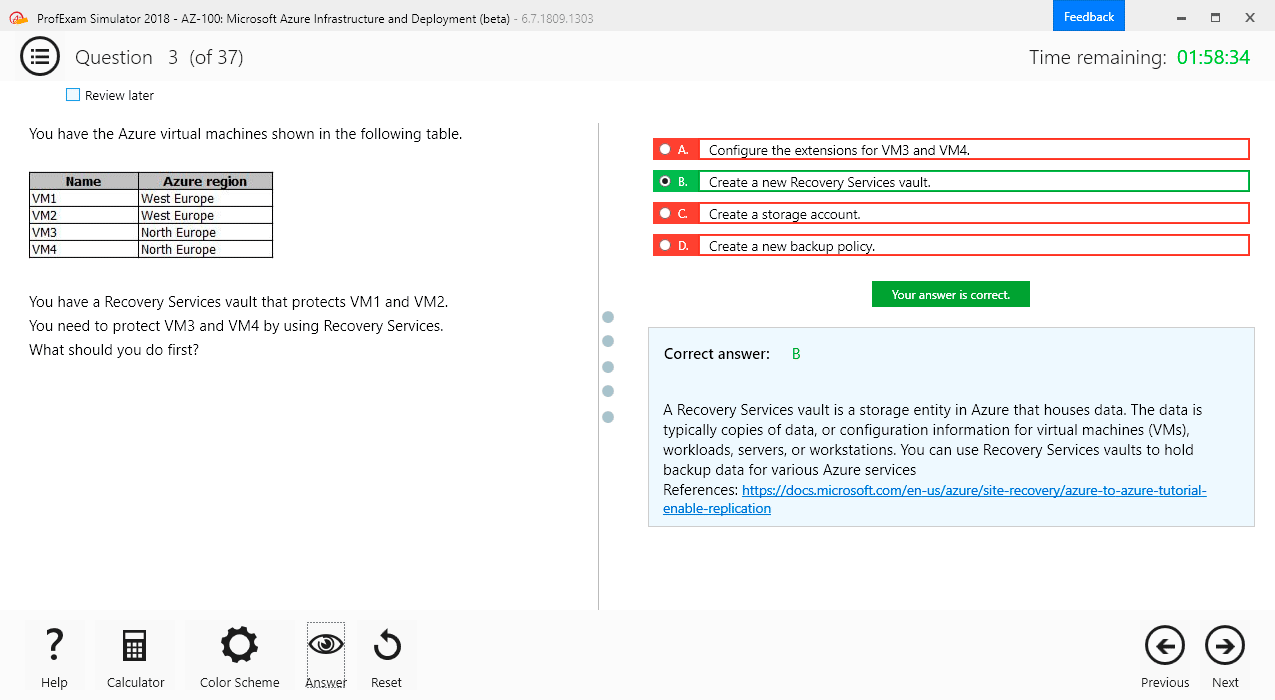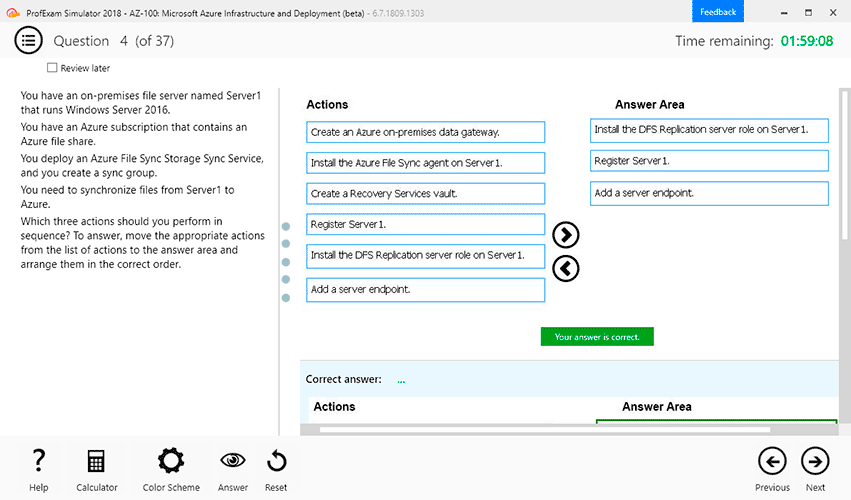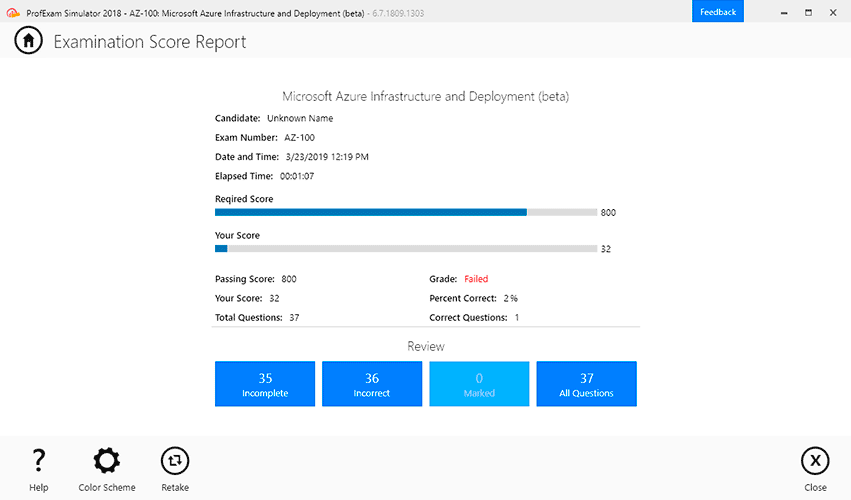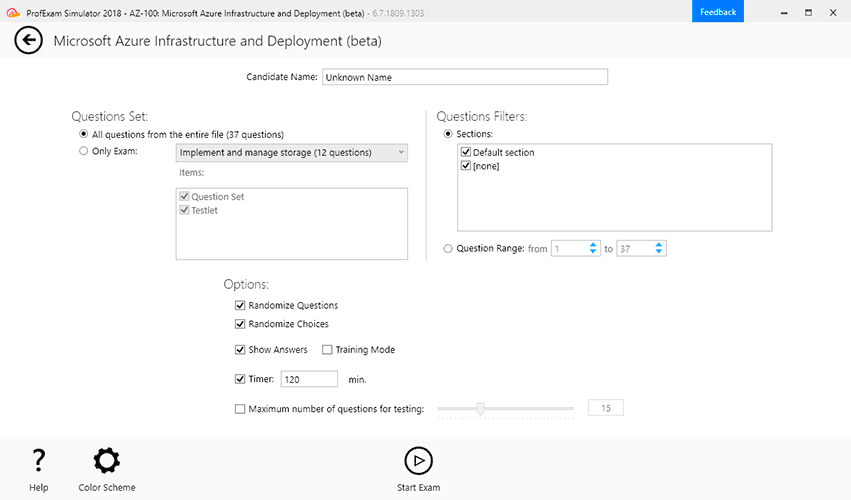File Info
| Exam | Cisco Environmental Sustainability Specialization |
| Number | 700-245 |
| File Name | Cisco.700-245.VCEplus.2024-08-21.28q.vcex |
| Size | 36 KB |
| Posted | Aug 21, 2024 |
| Download | Cisco.700-245.VCEplus.2024-08-21.28q.vcex |
How to open VCEX & EXAM Files?
Files with VCEX & EXAM extensions can be opened by ProfExam Simulator.
Coupon: MASTEREXAM
With discount: 20%





Demo Questions
Question 1
What is the innovative device called RACHEL?
- a device that acts as a miniature internet with built-in servers and Wi-Fi routers
- a Raspberry Pi device that can emulate a Cisco VPN
- a microcomputer capable of 2 trillion cycles a second
- the name of Cisco's Sustainability Program
Correct answer: A
Explanation:
RACHEL (Remote Area Community Hotspot for Education and Learning) is an innovative device that acts as a miniature internet with built-in servers and Wi-Fi routers. It is designed to bring educational resources to remote areas without reliable internet access. The device stores a large amount of offline content, such as educational materials, Wikipedia articles, Khan Academy videos, and open-source textbooks, which can be accessed by users via Wi-Fi without needing an internet connection. This is a powerful tool for promoting education in underserved regions, particularly in developing countries or areas affected by limited infrastructure.By enabling access to educational content without internet connectivity, RACHEL supports the United Nations' Sustainable Development Goals (SDGs), particularly those related to education and reducing inequalities.Environmental Sustainability References:World Possible. (2020). RACHEL -- Remote Area Community Hotspot for Education and Learning.United Nations Educational, Scientific and Cultural Organization (UNESCO). (2021). The Role of Technology in Expanding Access to Education. RACHEL (Remote Area Community Hotspot for Education and Learning) is an innovative device that acts as a miniature internet with built-in servers and Wi-Fi routers. It is designed to bring educational resources to remote areas without reliable internet access. The device stores a large amount of offline content, such as educational materials, Wikipedia articles, Khan Academy videos, and open-source textbooks, which can be accessed by users via Wi-Fi without needing an internet connection. This is a powerful tool for promoting education in underserved regions, particularly in developing countries or areas affected by limited infrastructure.
By enabling access to educational content without internet connectivity, RACHEL supports the United Nations' Sustainable Development Goals (SDGs), particularly those related to education and reducing inequalities.
Environmental Sustainability References:
World Possible. (2020). RACHEL -- Remote Area Community Hotspot for Education and Learning.
United Nations Educational, Scientific and Cultural Organization (UNESCO). (2021). The Role of Technology in Expanding Access to Education.
Question 2
Which feature was added to the headquarters of Cisco's partner, Charter, to support a responsible and sustainable environment?
- optimal building layout for space utilization
- reduction in hot water allowance to conserve energy
- Smart vehicles
- wireless components used to track people to determine who was leaving lights on
Correct answer: A
Explanation:
At the headquarters of Cisco's partner, Charter, a key feature added to support a responsible and sustainable environment was an optimal building layout for space utilization. Optimizing space utilization is a sustainability practice that reduces the environmental footprint by minimizing the amount of space required for operations, which in turn lowers energy consumption for heating, cooling, and lighting. A well-planned layout also improves operational efficiency, reduces costs, and encourages sustainable practices within the building, such as increased natural lighting and better ventilation, contributing to a more energy-efficient workspace.This sustainable design choice supports both environmental and operational goals by lowering resource consumption and fostering a more responsible, energy-efficient infrastructure.Environmental Sustainability References:U S. Green Building Council. (2020). Sustainable Building Design and Space Utilization Best Practices. Cisco. (2021). Sustainable Facilities and Space Optimization Strategies. At the headquarters of Cisco's partner, Charter, a key feature added to support a responsible and sustainable environment was an optimal building layout for space utilization. Optimizing space utilization is a sustainability practice that reduces the environmental footprint by minimizing the amount of space required for operations, which in turn lowers energy consumption for heating, cooling, and lighting. A well-planned layout also improves operational efficiency, reduces costs, and encourages sustainable practices within the building, such as increased natural lighting and better ventilation, contributing to a more energy-efficient workspace.
This sustainable design choice supports both environmental and operational goals by lowering resource consumption and fostering a more responsible, energy-efficient infrastructure.
Environmental Sustainability References:
U S. Green Building Council. (2020). Sustainable Building Design and Space Utilization Best Practices. Cisco. (2021). Sustainable Facilities and Space Optimization Strategies.
Question 3
Which task should be completed before meeting with a customer for an exploratory discussion?
- create a sales pitch
- prepare a proposal
- do background research
- determine product positioning
Correct answer: C
Explanation:
Before meeting with a customer for an exploratory discussion, the most important task to complete is doing background research. This involves understanding the customer's business, their industry, potential pain points, and any existing sustainability or technology initiatives they may have. Conducting thorough research allows you to tailor the discussion to the customer's needs, demonstrating that you understand their challenges and are prepared to offer relevant solutions.Preparation through research enables more productive conversations and increases the likelihood of establishing a strong, trust-based relationship with the customer.Environmental Sustainability References:Harvard Business Review. (2021). The Importance of Background Research in Customer Engagement.McKinsey & Company. (2020). How to Prepare for Successful Customer Meetings: A Research-Driven Approach. Before meeting with a customer for an exploratory discussion, the most important task to complete is doing background research. This involves understanding the customer's business, their industry, potential pain points, and any existing sustainability or technology initiatives they may have. Conducting thorough research allows you to tailor the discussion to the customer's needs, demonstrating that you understand their challenges and are prepared to offer relevant solutions.
Preparation through research enables more productive conversations and increases the likelihood of establishing a strong, trust-based relationship with the customer.
Environmental Sustainability References:
Harvard Business Review. (2021). The Importance of Background Research in Customer Engagement.
McKinsey & Company. (2020). How to Prepare for Successful Customer Meetings: A Research-Driven Approach.
Question 4
Which three factors contribute to employees asserting their preferences and organizations evaluating whether to return to the office, continue remote work, or go hybrid? (Choose three.)
- shortened workdays
- war for talent
- increased employee travel
- cost management
- the blurring of the workday
- increased demand on the workforce
Correct answer: BDE
Explanation:
Three factors contributing to organizations evaluating whether to return to the office, continue remote work, or adopt a hybrid model are:War for talent (B): Companies are competing to attract and retain skilled employees. Offering flexible work arrangements, such as remote or hybrid work, can be a crucial factor in appealing to top talent who prioritize worklife balance and flexibility.Cost management (D): Remote and hybrid work models can reduce operational costs, such as office space, utilities, and on-site amenities. Organizations are assessing the financial implications of maintaining large office spaces versus allowing more remote work.The blurring of the workday (E): As employees work remotely, the traditional boundaries between work and personal time have become less distinct. Companies are considering how hybrid models impact productivity, employee well-being, and work-life balance.Environmental Sustainability References:Gartner. (2021). Remote Work, the War for Talent, and Organizational Decision-Making.Harvard Business Review. (2021). How Cost Management Influences Remote and Hybrid Work Decisions.McKinsey & Company. (2021). The Future of Hybrid Work: Flexibility, Talent, and Work-Life Balance. Three factors contributing to organizations evaluating whether to return to the office, continue remote work, or adopt a hybrid model are:
War for talent (B): Companies are competing to attract and retain skilled employees. Offering flexible work arrangements, such as remote or hybrid work, can be a crucial factor in appealing to top talent who prioritize worklife balance and flexibility.
Cost management (D): Remote and hybrid work models can reduce operational costs, such as office space, utilities, and on-site amenities. Organizations are assessing the financial implications of maintaining large office spaces versus allowing more remote work.
The blurring of the workday (E): As employees work remotely, the traditional boundaries between work and personal time have become less distinct. Companies are considering how hybrid models impact productivity, employee well-being, and work-life balance.
Environmental Sustainability References:
Gartner. (2021). Remote Work, the War for Talent, and Organizational Decision-Making.
Harvard Business Review. (2021). How Cost Management Influences Remote and Hybrid Work Decisions.
McKinsey & Company. (2021). The Future of Hybrid Work: Flexibility, Talent, and Work-Life Balance.
Question 5
Which percentage of the worldwide wastewater returns to the environment untreated?
- 60%
- 63%
- 30%
- 90%
Correct answer: D
Explanation:
Globally, 90% of wastewater returns to the environment untreated. This untreated wastewater, which includes industrial, agricultural, and household waste, leads to widespread pollution of rivers, lakes, and oceans, posing serious risks to ecosystems, human health, and water quality. The lack of proper wastewater treatment is especially prevalent in developing regions, where infrastructure and resources for waste management are often limited.Effective wastewater management and treatment are crucial for protecting water resources and supporting sustainability goals, such as those outlined in the United Nations Sustainable Development Goals (SDGs).Environmental Sustainability References:United Nations World Water Development Report (UNWWDR). (2021). Wastewater: The Untreated Crisis.World Health Organization (WHO). (2020). Global Wastewater Management and Environmental Impact.United Nations Environment Programme (UNEP). (2020). Wastewater Treatment and Sustainable Development. Globally, 90% of wastewater returns to the environment untreated. This untreated wastewater, which includes industrial, agricultural, and household waste, leads to widespread pollution of rivers, lakes, and oceans, posing serious risks to ecosystems, human health, and water quality. The lack of proper wastewater treatment is especially prevalent in developing regions, where infrastructure and resources for waste management are often limited.
Effective wastewater management and treatment are crucial for protecting water resources and supporting sustainability goals, such as those outlined in the United Nations Sustainable Development Goals (SDGs).
Environmental Sustainability References:
United Nations World Water Development Report (UNWWDR). (2021). Wastewater: The Untreated Crisis.
World Health Organization (WHO). (2020). Global Wastewater Management and Environmental Impact.
United Nations Environment Programme (UNEP). (2020). Wastewater Treatment and Sustainable Development.
Question 6
By what year has Cisco pledged support for climate actions to reach net-zero emissions?
- 2025
- 2030
- 2035
- 2040
Correct answer: D
Explanation:
Cisco has pledged to achieve net-zero emissions by 2040 across its entire value chain, including Scope 1, 2, and 3 emissions. This comprehensive target includes reducing direct emissions (Scope 1), emissions from purchased energy (Scope 2), and indirect emissions across the supply chain and product lifecycle (Scope 3). Cisco's strategy includes increasing energy efficiency, adopting renewable energy, and developing circular economy practices to ensure this goal is met. The company is also committed to meeting interim goals by 2030, reducing Scope 1 and 2 emissions by 90%.Environmental Sustainability References:Cisco. (2021). Cisco's 2040 Net-Zero Emissions Pledge.United Nations Framework Convention on Climate Change (UNFCCC). (2021). Corporate Commitments to Achieve Net-Zero by 2040.World Economic Forum. (2021). Pathways to Net-Zero: Cisco's Leadership in Climate Action. Cisco has pledged to achieve net-zero emissions by 2040 across its entire value chain, including Scope 1, 2, and 3 emissions. This comprehensive target includes reducing direct emissions (Scope 1), emissions from purchased energy (Scope 2), and indirect emissions across the supply chain and product lifecycle (Scope 3). Cisco's strategy includes increasing energy efficiency, adopting renewable energy, and developing circular economy practices to ensure this goal is met. The company is also committed to meeting interim goals by 2030, reducing Scope 1 and 2 emissions by 90%.
Environmental Sustainability References:
Cisco. (2021). Cisco's 2040 Net-Zero Emissions Pledge.
United Nations Framework Convention on Climate Change (UNFCCC). (2021). Corporate Commitments to Achieve Net-Zero by 2040.
World Economic Forum. (2021). Pathways to Net-Zero: Cisco's Leadership in Climate Action.
Question 7
Which three factors are driving the trend of Smart building growth in the coming years? (Choose three.)
- security concerns
- customer demands
- lack of bank funding for traditional buildings
- government-sponsored smart infrastructure projects
- pressure from the labor force
- increases in energy costs and consumption
Correct answer: BDF
Explanation:
Three key factors driving the growth of Smart buildings in the coming years are:Customer demands (B): Customers are increasingly seeking energy-efficient, sustainable, and tech-enabled spaces that enhance comfort and reduce operating costs. Smart buildings, equipped with IoT and data analytics, provide a higher level of efficiency and adaptability, making them attractive to businesses and consumers.Government-sponsored smart infrastructure projects (D): Many governments are investing in smart infrastructure projects to promote sustainability and energy efficiency in urban development. These projects encourage the adoption of smart building technologies to meet sustainability goals, reduce energy consumption, and improve public infrastructure.Increases in energy costs and consumption (F): Rising energy costs are a significant driver for adopting smart building technologies, which can optimize energy use and reduce utility bills. Advanced systems like smart sensors and automated energy management help minimize waste and ensure efficient use of resources, providing long-term cost savings.Environmental Sustainability References:International Energy Agency (IEA). (2021). Smart Buildings: Trends and Drivers for Growth.World Economic Forum. (2021). Smart Building Technologies and the Future of Urban Development.Cisco. (2022). Customer and Regulatory Drivers for Smart Building Adoption. Three key factors driving the growth of Smart buildings in the coming years are:
Customer demands (B): Customers are increasingly seeking energy-efficient, sustainable, and tech-enabled spaces that enhance comfort and reduce operating costs. Smart buildings, equipped with IoT and data analytics, provide a higher level of efficiency and adaptability, making them attractive to businesses and consumers.
Government-sponsored smart infrastructure projects (D): Many governments are investing in smart infrastructure projects to promote sustainability and energy efficiency in urban development. These projects encourage the adoption of smart building technologies to meet sustainability goals, reduce energy consumption, and improve public infrastructure.
Increases in energy costs and consumption (F): Rising energy costs are a significant driver for adopting smart building technologies, which can optimize energy use and reduce utility bills. Advanced systems like smart sensors and automated energy management help minimize waste and ensure efficient use of resources, providing long-term cost savings.
Environmental Sustainability References:
International Energy Agency (IEA). (2021). Smart Buildings: Trends and Drivers for Growth.
World Economic Forum. (2021). Smart Building Technologies and the Future of Urban Development.
Cisco. (2022). Customer and Regulatory Drivers for Smart Building Adoption.
Question 8
Which program is available to help customers return their equipment if it is unable to be powered on?
- Send IT Back Mobile Agg
- Cisco Refresh
- Customer Recycling Solutions
- Cisco Return Program
Correct answer: C
Explanation:
Cisco's Customer Recycling Solutions program is designed to help customers return equipment that can no longer be powered on or is at the end of its life cycle. This program ensures that products are responsibly recycled or refurbished, supporting the circular economy and minimizing electronic waste. By offering this service, Cisco helps customers properly dispose of non-functioning equipment, keeping it out of landfills and contributing to environmental sustainability goals.Environmental Sustainability References:Cisco. (2021). Customer Recycling Solutions: Supporting Responsible Equipment Disposal.Ellen MacArthur Foundation. (2020). Circular Economy and E-Waste Management.United Nations Environment Programme (UNEP). (2021). Sustainable E-Waste Solutions for IT Equipment. Cisco's Customer Recycling Solutions program is designed to help customers return equipment that can no longer be powered on or is at the end of its life cycle. This program ensures that products are responsibly recycled or refurbished, supporting the circular economy and minimizing electronic waste. By offering this service, Cisco helps customers properly dispose of non-functioning equipment, keeping it out of landfills and contributing to environmental sustainability goals.
Environmental Sustainability References:
Cisco. (2021). Customer Recycling Solutions: Supporting Responsible Equipment Disposal.
Ellen MacArthur Foundation. (2020). Circular Economy and E-Waste Management.
United Nations Environment Programme (UNEP). (2021). Sustainable E-Waste Solutions for IT Equipment.
Question 9
Which two resources provide information about an organization's position and plans around sustainability? (Choose two.)
- online blog posts
- corporate tax reports
- employee retention statistics
- corporate salaries
- company websites
Correct answer: AE
Explanation:
Two key resources that provide information about an organization's sustainability position and plans are:Online blog posts (A): Companies frequently use blogs to share their sustainability initiatives, progress, and future goals. These posts often highlight achievements, such as reducing carbon emissions or improving energy efficiency, and communicate their commitment to stakeholders.Company websites (E): The corporate website is one of the most comprehensive sources of information about a company's sustainability strategy. Organizations often dedicate sections of their websites to sustainability, where they detail their environmental policies, sustainability reports, and plans for reducing their environmental impact.Environmental Sustainability References:Global Reporting Initiative (GRI). (2020). Corporate Sustainability Communication through Websites and Blogs.Harvard Business Review. (2021). How Companies Use Digital Platforms to Showcase Sustainability Efforts.McKinsey & Company. (2021). Communicating Corporate Sustainability: The Role of Digital Channels. Two key resources that provide information about an organization's sustainability position and plans are:
Online blog posts (A): Companies frequently use blogs to share their sustainability initiatives, progress, and future goals. These posts often highlight achievements, such as reducing carbon emissions or improving energy efficiency, and communicate their commitment to stakeholders.
Company websites (E): The corporate website is one of the most comprehensive sources of information about a company's sustainability strategy. Organizations often dedicate sections of their websites to sustainability, where they detail their environmental policies, sustainability reports, and plans for reducing their environmental impact.
Environmental Sustainability References:
Global Reporting Initiative (GRI). (2020). Corporate Sustainability Communication through Websites and Blogs.
Harvard Business Review. (2021). How Companies Use Digital Platforms to Showcase Sustainability Efforts.
McKinsey & Company. (2021). Communicating Corporate Sustainability: The Role of Digital Channels.
Question 10
Which country has a history of implementing waste management sustainability practices?
- Thailand
- Germany
- Russia
- Japan
Correct answer: B
Explanation:
Germany is widely regarded for its history of implementing effective waste management sustainability practices. The country has long been a global leader in waste reduction, recycling, and circular economy initiatives.Germany's recycling system, known as the Dual System, enforces the separation of waste at the source and has established extensive recycling and waste treatment facilities. Germany's Packaging Act and Extended Producer Responsibility (EPR) laws place the responsibility on manufacturers to manage the lifecycle of their products, including their disposal and recycling.Germany's focus on reducing landfill use, promoting recycling, and developing waste-to-energy technologies has made it a model for sustainable waste management.Environmental Sustainability References:European Environment Agency (EEA). (2020). Germany's Leadership in Waste Management and Circular Economy Practices.Ellen MacArthur Foundation. (2021). Germany: A Pioneer in Circular Economy and Waste Management.World Economic Forum. (2022). Waste Management Success in Germany and Global Lessons. Germany is widely regarded for its history of implementing effective waste management sustainability practices. The country has long been a global leader in waste reduction, recycling, and circular economy initiatives.
Germany's recycling system, known as the Dual System, enforces the separation of waste at the source and has established extensive recycling and waste treatment facilities. Germany's Packaging Act and Extended Producer Responsibility (EPR) laws place the responsibility on manufacturers to manage the lifecycle of their products, including their disposal and recycling.
Germany's focus on reducing landfill use, promoting recycling, and developing waste-to-energy technologies has made it a model for sustainable waste management.
Environmental Sustainability References:
European Environment Agency (EEA). (2020). Germany's Leadership in Waste Management and Circular Economy Practices.
Ellen MacArthur Foundation. (2021). Germany: A Pioneer in Circular Economy and Waste Management.
World Economic Forum. (2022). Waste Management Success in Germany and Global Lessons.

